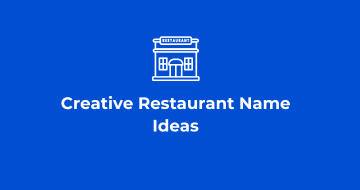What Is Restaurant Name Generator?
Restaurant name generator is an AI-powered online tool that helps you create thousands of restaurant name ideas. It also helps you to check domain availability immediately.
Top Tips
How to Name a Restaurant
Your restaurant name is how people will identify your food business. It is the foundation of your brand and shapes the first impression of your potential customers. Good names for restaurants effectively represent the restaurant’s values, connect with your target audience, and set the stage for a successful restaurant business.

Simplicity
Limit your restaurant name or food store name to a maximum of 3 words. A short, memorable name is best. Stay away from words that could confuse customers.

Get Some Help
Generator tools are the best thing that ever happened to business owners seeking inspiration for naming their restaurants. A fancy restaurant name generator removes the creative block and helps you discover even more fantastic names than you have imagined.

Check Availability
Standing out in the industry begins with your restaurant name. Our restaurant name generator helps you check if your preferred names are free to register as web domains.

Focus on Style
If you have a distinct menu, experience or vibe, highlight that. Names like ‘The Burger Joint’ or ‘Whiskey & Rye’ convey the concept immediately. You can even combine a core theme of your restaurant with one of the suggestions that pops up.

Consider Location
If there’s something distinctive about your location or building, consider drawing inspiration from there. But only if it’s meaningful. Forced attempts come across as tacky.

Test It Out
Now you’ve selected a handful of names you’ll love to use, say them out loud to make sure they sound professional and roll off the tongue easily. Get feedback from friends and family too. Run a competition or poll via social media to select the best one.
Get Inspired
20 Restaurant Names Ideas to Inspire You
If you find yourself struggling to come up with good names for restaurants, we have compiled some unique and catchy restaurant name ideas to get you started:
- Deli Feast
- Feast Lounge
- Feast Palace
- Island Grill
- Flavoroso
- Green Curry
- El Pirata Porch
- Sweet Escape
- Salty Squid
- Bangalore Spices
- Pancake World
- Veganic Corner
- Masala
- Grub Chef
- Grub lord
- Kitchen Sensation
- Kitchen Takeout
- Menu Gusto
- Munchies
- Munchtastic
More Name Ideas for Inspiration
Street Food Name Ideas
A good street food restaurant name is exciting and catchy, and it reflects the cuisine that potential customers can expect. Below are some cool street food name ideas our restaurant name generator came up with:
| 1. Wings Wonder 2. Tasty Temple 3. Roast Dash 4. Grill Gems 5. Hot Dog Devour | 6. Burger Bonfire 7. Patty Parlor 8. Grill Treats 9. Cookout Craze 10. Zestywrap |
Food Delivery and Takeaway Name Ideas
Whether you are starting a food store or a fast food restaurant that offers delivery and takeaway options, you want a name that conveys a sense of deliciousness, convenience, and quality. Here are some name ideas you can consider:
| 1. Cuisine Cupid 2. BBQ Harbor 3. Pasta Peak 4. Piping Plates 5. Hop Hunger | 6. Speedy Sizzle 7. Flash Snack 8. Hungry Hurry 9. Toasty Crunch 10. Deli Drizzle |







